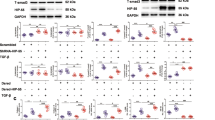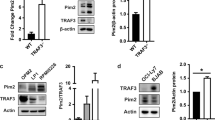Abstract
Transforming growth factor-β (TGF-β) is a multifunctional growth factor that has a principal role in growth control through both its cytostatic effect on many different epithelial cell types and its ability to induce programmed cell death in a variety of other cell types. Here we have used a screen for proteins that interact physically with the cytoplasmic domain of the type II TGF-β receptor to isolate the gene encoding Daxx — a protein associated with the Fas receptor that mediates activation of Jun amino-terminal kinase (JNK) and programmed cell death induced by Fas. The carboxy-terminal portion of Daxx functions as a dominant-negative inhibitor of TGF-β-induced apoptosis in B-cell lymphomas, and antisense oligonucleotides to Daxx inhibit TGF-β-induced apoptosis in mouse hepatocytes. Furthermore, Daxx is involved in mediating JNK activation by TGF-β. Our findings associate Daxx directly with the TGF-β apoptotic-signalling pathway, and make a biochemical connection between the receptors for TGF-β and the apoptotic machinery.
This is a preview of subscription content, access via your institution
Access options
Subscribe to this journal
Receive 12 print issues and online access
$209.00 per year
only $17.42 per issue
Buy this article
- Purchase on Springer Link
- Instant access to full article PDF
Prices may be subject to local taxes which are calculated during checkout




Similar content being viewed by others
References
Massague, J. The transforming growth factor-β family. Annu. Rev. Cell Biol. 6, 597–641 (1990).
Letterio, J. J. & Roberts, A. B. TGF-β: a critical modulator of immune cell function. Clin. Immunol. Immunopathol. 84, 244–250 (1997).
Shull, M. M. et al. Targeted disruption of the mouse transforming growth factor-β1 gene results in multifocal inflammatory disease. Nature 359, 693–699 (1992).
Kulkarni, A. B. et al. Transforming growth factor β1 null mutation in mice causes excessive inflammatory response and early death. Proc. Natl Acad. Sci. USA 90, 770–774 (1993).
Dang, H. et al. SLE-like autoantibodies and Sjogren's syndrome-like lymphoproliferation in TGF-β knockout mice. J. Immunol. 155, 3205–3212 (1995).
Fischer, G., Kent, S. C., Joseph, L., Green, D. R. & Scott, D. W. Lymphoma models for B cell activation and tolerance. X. Anti-mu-mediated growth arrest and apoptosis of murine B cell lymphomas is prevented by the stabilization of myc. J. Exp. Med. 179, 221–228 (1994).
Chaouchi, N. et al. Characterization of transforming growth factor-β1 induced apoptosis in normal human B cells and lymphoma B cell lines. Oncogene 11, 1615–1622 (1995).
Arsura, M., Wu, M. & Sonenshein, G. E. TGF β1 inhibits NF-κB/Rel activity inducing apoptosis of B cells: transcriptional activation of IκBα. Immunity 5, 31–40 (1996).
McMahon, J. B., Richards, W. L., del Campo, A. A., Song, M. K. & Thorgeirsson, S. S. Differential effects of transforming growth factor-β on proliferation of normal and malignant rat liver epithelial cells in culture. Cancer Res. 46, 4665–4671 (1986).
Sanderson, N. et al. Hepatic expression of mature transforming growth factor β1 in transgenic mice results in multiple tissue lesions. Proc. Natl Acad. Sci. USA 92, 2572–2576 (1995).
Arsura, M., Fitz Gerald, M. J., Fausto, N. & Sonenshein, G. E. Nuclear factor-κB/Rel blocks transforming growth factor β1-induced apoptosis of murine hepatocyte cell lines. Cell Growth Differ. 8, 1049–1059 (1997).
Jacobson, M. D., Weil, M. & Raff, M. C. Programmed cell death in animal development. Cell 88, 347–354 (1997).
Evan, G. & Littlewood, T. A matter of life and cell death. Science 281, 1317–1322 (1998).
Abbas, A. K. Die and let live: eliminating dangerous lymphocytes. Cell 84, 655–657 (1996).
Nagata, S. Apoptosis by death factor. Cell 88, 355–365 (1997).
Massague, J. & Weis-Garcia, F. Serine/threonine kinase receptors: mediators of transforming growth factor β family signals. Cancer Surv. 27, 41–64 (1996).
Wieser, R., Wrana, J. L. & Massague, J. GS domain mutations that constitutively activate TβR-I, the downstream signaling component in the TGF-β receptor complex. EMBO J. 14, 2199–2208 (1995).
Derynck, R., Zhang, Y. & Feng, X. H. Smads: transcriptional activators of TGF-β responses. Cell 95, 737–740 (1998).
Atfi, A., Buisine, M., Mazars, A. & Gespach, C. Induction of apoptosis by DPC4, a transcriptional factor regulated by transforming growth factor-β through stress-activated protein kinase/c-Jun N-terminal kinase (SAPK/JNK) signaling pathway. J. Biol. Chem. 272, 24731–24734 (1997).
Chen, R. H. & Chang, T. Y. Involvement of caspase family proteases in transforming growth factor-β-induced apoptosis. Cell Growth Differ. 8, 821–827 (1997).
Brown, T. L., Patil, S., Basnett, R. K. & Howe, P. H. Caspase inhibitor BD-fmk distinguishes transforming growth factor β-induced apoptosis from growth inhibition. Cell Growth Differ. 9, 869–875 (1998).
Le Dai, J., Bansal, R. K. & Kern, S. E. G1 cell cycle arrest and apoptosis induction by nuclear Smad4/Dpc4: phenotypes reversed by a tumorigenic mutation. Proc. Natl Acad. Sci. USA 96, 1427–1432 (1999).
Yang, X., Khosravi-Far, R., Chang, H. Y. & Baltimore, D. Daxx, a novel Fas-binding protein that activates JNK and apoptosis. Cell 89, 1067–1076 (1997).
Chang, H. Y., Nishitoh, H., Yang, X., Ichijo, H. & Baltimore, D. Activation of apoptosis signal-regulating kinase 1 (ASK1) by the adapter protein Daxx. Science 281, 1860–1863 (1998).
Chang, H. Y., Yang, X. & Baltimore, D. Dissecting Fas signaling with an altered-specificity death-domain mutant: requirement of FADD binding for apoptosis but not Jun N-terminal kinase activation. Proc. Natl Acad. Sci. USA 96, 1252–1256 (1999).
Gyuris, J., Golemis, E., Chertkov, H. & Brent, R. Cdi1, a human G1 and S phase protein phosphatase that associates with Cdk2. Cell 75, 791–803 (1993).
Estevez, M. et al. The daf-4 gene encodes a bone morphogenetic protein receptor controlling C. elegans dauer larva development. Nature 365, 644–649 (1993).
Torii, S., Egan, D. A., Evans, R. A. & Reed, J. C. Human daxx regulates fas-induced apoptosis from nuclear PML oncogenic domains (PODs). EMBO J. 18, 6037–6049 (1999).
Goillot, E. et al. Mitogen-activated protein kinase-mediated Fas apoptotic signaling pathway. Proc. Natl Acad. Sci. USA 94, 3302–3307 (1997).
Michaelson, J. S., Bader, D., Kuo, F., Kozak, C. & Leder, P. Loss of Daxx, a promiscuously interacting protein, results in extensive apoptosis in early mouse development. Genes Dev. 13, 1918–1923 (1999).
Chen, F. & Weinberg, R. A. Biochemical evidence for the autophosphorylation and transphosphorylation of transforming growth factor β receptor kinases. Proc. Natl Acad. Sci. USA 92, 1565–1569 (1995).
Wu, J. C., Merlino, G. & Fausto, N. Establishment and characterization of differentiated, nontransformed hepatocyte cell lines derived from mice transgenic for transforming growth factor α. Proc. Natl Acad. Sci. USA 91, 674–678 (1994).
Zhong, S. et al. Promyelocytic leukemia protein (PML) and Daxx participate in a novel nuclear pathway for apoptosis. J. Exp. Med. 191, 631–640 (2000).
Goodwin, G. H. Isolation of Nuclei 97–101 (Oxford Univ. Press, New York, 1989).
Chan, D. C. & Leder, P. Genetic evidence that formins function within the nucleus. J. Biol. Chem. 271, 23472–23477 (1996).
Liu, X. et al. Transforming growth factor β-induced phosphorylation of Smad3 is required for growth inhibition and transcriptional induction in epithelial cells. Proc. Natl Acad. Sci. USA 94, 10669–10674 (1997).
Yamaguchi, K. et al. Identification of a member of the MAPKKK family as a potential mediator of TGF-β signal transduction. Science 270, 2008–2011 (1995).
Atfi, A., Djelloul, S., Chastre, E., Davis, R. & Gespach, C. Evidence for a role of Rho-like GTPases and stress-activated protein kinase/c-Jun N-terminal kinase (SAPK/JNK) in transforming growth factor β-mediated signaling. J. Biol. Chem. 272, 1429–1432 (1997).
Wang, W., Zhou, G., Hu, M. C. T., Yao, Z. & Tan, T. H. Activation of the hematopoietic progenitor kinase-1 (HPK1)-dependent, stress-activated c-Jun N-terminal kinase (JNK) pathway by transforming growth factor β (TGF-β)-activated kinase (TAK1), a kinase mediator of TGF β signal transduction. J. Biol. Chem. 272, 22771–22775 (1997).
Choy, L. & Derynck, R. The type II transforming growth factor (TGF)-β receptor-interacting protein TRIP-1 acts as a modulator of the TGF-β response. J. Biol. Chem. 273, 31455–31462 (1998).
Pear, W. S., Nolan, G. P., Scott, M. L. & Baltimore, D. Production of high-titer helper-free retroviruses by transient transfection. Proc. Natl Acad. Sci. USA 90, 8392–8396 (1993).
Ullrich, A. & Schlessinger, J. Signal transduction by receptors with tyrosine kinase activity. Cell 61, 203–212 (1990).
Pawson, T. & Gish, G. D. SH2 and SH3 domains: from structure to function. Cell 71, 359–362 (1992).
Wang, T., Donahoe, P. K. & Zervos, A. S. Specific interaction of type I receptors of the TGF-β family with the immunophilin FKBP-12. Science 265, 674–676 (1994).
Chen, R. H., Miettinen, P. J., Maruoka, E. M., Choy, L. & Derynck, R. A WD-domain protein that is associated with and phosphorylated by the type II TGF-β receptor. Nature 377, 548–552 (1995).
Griswold-Prenner, I., Kamibayashi, C., Maruoka, E. M., Mumby, M. C. & Derynck, R. Physical and functional interactions between type I transforming growth factor β receptors and Bα, a WD-40 repeat subunit of phosphatase 2A. Mol. Cell. Biol. 18, 6595–6604 (1998).
Tsukazaki, T., Chiang, T. A., Davison, A. F., Attisano, L. & Wrana, J. L. SARA, a FYVE domain protein that recruits Smad2 to the TGFβ receptor. Cell 95, 779–791 (1998).
Yamaguchi, K. et al. XIAP, a cellular member of the inhibitor of apoptosis protein family, links the receptors to TAB1-TAK1 in the BMP signaling pathway. EMBO J. 18, 179–187 (1999).
Wells, R. G. et al. Transforming growth factor-β induces formation of a dithiothreitol-resistant type I/Type II receptor complex in live cells. J. Biol. Chem. 274, 5716–5722 (1999).
Sicinski, P. et al. Cyclin D2 is an FSH-responsive gene involved in gonadal cell proliferation and oncogenesis. Nature 384, 470–474 (1996).
Acknowledgements
We are grateful to R. Brent for the yeast two-hybrid system; and to X. Yang for Daxx plasmids and discussions. We thank F. Chen, W. Vale, D. Riddle, X. Liu, J. Kyriakis and R. Lin for plasmids; D. W. Scott for CH33 cells; N. Fausto for AML12 cells; F. McKeon for anti-lamin 1E4 monoclonal antibodies; G. Paradis and M. Jennings for flow cytometry; P. Salomoni and P. Pandolfi for discussions and sharing unpublished results; and B. Osborne, S. Stewart and A. Sherman for reading the manuscript. We are especially grateful to M. Chen for her help, and all members of the Weinberg and Lodish laboratories. R.P. would like to express special thanks to A. Sherman for his advice, help and support. This work was supported by an NIH/NCI grant to R.A.W. and an NIH grant to H.F.L. R.P. was supported by the Israel Cancer Research Foundation, Human Frontiers Science Program and Cancer Research Foundation of America postdoctoral fellowships. W.P.S. was supported by the National Cancer Institute postdoctoral fellowship. R.A.W. is an American Cancer Society Research Professor and a Daniel K. Ludwig Cancer Research Professor.
Author information
Authors and Affiliations
Rights and permissions
About this article
Cite this article
Perlman, R., Schiemann, W., Brooks, M. et al. TGF-β-induced apoptosis is mediated by the adapter protein Daxx that facilitates JNK activation. Nat Cell Biol 3, 708–714 (2001). https://doi.org/10.1038/35087019
Received:
Revised:
Accepted:
Published:
Issue Date:
DOI: https://doi.org/10.1038/35087019
This article is cited by
-
Multipronged regulation of autophagy and apoptosis: emerging role of TRIM proteins
Cellular & Molecular Biology Letters (2024)
-
In silico analysis to identify miR-1271-5p/PLCB4 (phospholipase C Beta 4) axis mediated oxaliplatin resistance in metastatic colorectal cancer
Scientific Reports (2023)
-
Zinc-nanoparticles alleviate the ovarian damage induced by bacterial lipopolysaccharide (LPS) in pregnant rats and their fetuses
Histochemistry and Cell Biology (2023)
-
Classical epithelial-mesenchymal transition (EMT) and alternative cell death process-driven blebbishield metastatic-witch (BMW) pathways to cancer metastasis
Signal Transduction and Targeted Therapy (2022)
-
DAXX represents a new type of protein-folding enabler
Nature (2021)



